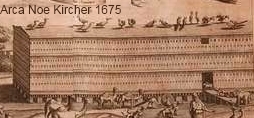
After the Flood
your wife, and your sons and your sons' wives with you.
Gen 8:17 Bring out with you every living thing with you of all flesh
--birds and animals and every creeping thing that creeps on the land--
that they may swarm on the land, and be fruitful and multiply on the land."
Gen 9:1 And God blessed Noah and his sons and said to them, "Be fruitful and multiply and fill the earth. ..."
Any natural cause for the flood must be relatively short-lived. In order for the larger animals and humans to survive, the area where they landed should return to a near normal habitat in a short time. The Biblical chronology requires the heavy rains to stop after 40 days and for the land to become dry enough for the occupants of the ark to emerge after 377 days inside. (ref. Bible Knowledge Commentary) More than two months before they left the ark, plant growth was present when the dove returned to Noah with a plucked leaf. And seven days after that the dove did not return to the ark, "a sign that (there was) sufficient food to eat, and a proper place for its habitation ..." (source Gill's Exposition...). Within a short time, Noah was able to plant and harvest a vineyard. If the ocean waters were heated considerably due to subsurface volcanic activity along the mid-ocean ridges, as one flood theory proposes, it would take a relatively long time for the ocean to return to near normal temperatures.
Some documented theories include: "There are many volcanic rocks interspersed
between the fossil layers in the rock record—layers that were obviously deposited
during Noah's flood."(source AIG article)
"Coal and oil are the obvious result of the activity of Noah's Flood.
During the Flood of Noah (about 4,350 years ago) great amounts of superheated water came up
out of the earth and mixed with the waters that were on the surface and those that rained down from above.
In addition, the hot rock and hot ash from thousands of volcanoes was available to generate many layers
of heated sedimentary materials. Ground makes a very good insulator capable of maintaining
heat for long periods of time. At the beginning of the Flood thousands of volcanoes mowed
down forests all over the world. Volcanic ash fell on top of huge floating log mats.
When those log mats were buried in-between the heated sedimentary layers deposited by the Flood,
coal and oil were formed in a short amount of time."
(source www.creationworldview.org)
The translators of the Good News Bible and others interject a theory contrary to verses in Isaiah and Psalms, when they paraphrase it as "... on the seventeenth day of the second month all the ?? outlets of the vast body of water beneath the earth burst open ??, ..." The Hebrew is the same as Isaiah 51:10 and defines "the sea," as "the waters of the great deep" ... GNB ignores it! God's Word has "the water of the great ocean". Also in Psalms 36:6 "great deep" is "depths of the sea" in GNB, and "the deep ocean" in God's Word.
There is no Biblical basis or Hebrew justification to see the flood event as a
global catastrophe involving volcanic action! Per Strong only one Hebrew word has a
possible connection to volcanism, H5467 "From an unused root meaning to scorch; burnt
(that is, volcanic or bituminous) district; Sedom, a place near the Dead Sea: Sodom."
Additionally there is no mention of any volcanism in Brown-Driver-Briggs Lexicon, so obviously
neither Strong or Brown-Driver-Briggs mention volcanism in the definitions of the
Hebrew words H4599 "wells/fountains/springs", H8415 "deep/abyss", and H1234 "cleaved/broken up" used in Genesis 7:11 !
Genesis 7:11 "... all the wells (H4599 always water related, never volcanic) of the great deep were cleaved/broken up (H1234 "A primitive root; to cleave; generally to rend, break, rip or open:"),
and the sky’s windows were opened."
"According to NASA, as of September 2021, the number of known comets is 3,743. Many more are thought to be orbiting the sun beyond Neptune in the Kuiper Belt ... Their unique orbits lie near the plane of the Earth's orbit around the Sun. All go around the Sun in the same direction as the planets." (source http://www.solar views.com/eng/kuiper.htm) A 2008 study indicated that as our solar system moves through the Milky Way it some times changes the orbit of some of the comets, enough to possibly cause them to impact the earth. Such an event probably caused the present orbit of "Halley's comet, a roughly potato-shaped, 9-mile-long (15 km) comet with equal parts ice and dust, and some 80% of the ice is water"... (source "Comets: Facts about the 'dirty snowballs' of space") Therefore, the flood comet most likely came from the Kuiper Belt.
Jewish writings explain what brought the deluge to the world, and from where it appeared to come !
"When the Holy One ... wanted to bring a flood upon the world,
He took two stars from Khima and brought a flood upon the world." is a quote
from the English translation (by Maurice Simon, 1948) of the Tractate Brakhot of the Babylonian Talmud.
Khima/Kimah/Kiymah is mentioned in Job 9:9, Job 38:31, and Amos 5:8. The BDB definition is H3598 Kiymah:
Pleiades, a constellation of 7 stars. No Biblical Hebrew word is translated as comet.
It can be assumed that "star" means any small bright shining object in the sky,
as when a comet is beyond the inner solar system the tail does not show.
"two stars": "comet Biela—discovered in 1826 and detected again in 1832—was observed
to suddenly split into two distinct fragments, which continued to journey side by side
along the same orbit. Eventually, both parts of Biela developed into complete comets
with tails and both reappeared in 1852, but they were never seen again." (source siencedirect.com/.../comet-tails)
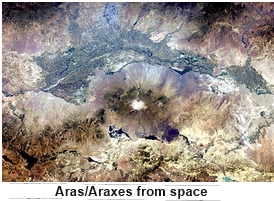
Extent of the flood: Commenting on Gen_7:19 Albert Barnes wrote: "Upon the land. - The land is to be understood of the portion of the earth’s surface known to man. This, with an unknown margin beyond it, was covered with the waters. But this is all that Scripture warrants us to assert. Concerning the distant parts of Europe, the continents of Africa, America, or Australia, we can say nothing. 'All the high hills were covered.' Not a hill was above water within the horizon of the spectator or of man." "Local tradition states that Nakhchivan was founded by Noah after the Flood, and was his place of death and burial." (source Wikipedia-Nakhchivan) According to this concept we can only know that the 40 day rain and 150 days of the waters prevailing on the land applies to a greater area centered about the Aras/Araxes river valley.
Return to near normal growing seasons due to a "dirty snowball" comet shower would seem to depend upon the size and number of fragments and the percentage of solid material versus water contained within the comet. The heavy rainfall from the portion of the comet's water that vaporized in the atmosphere would clean the air and minimize the effect of dust clouds occurring from land impacts. Since the Creator provides the comet, the ark landing area would return to normal growing seasons exactly when it was needed by those leaving the ark.
Addenda - More on Pleiades and comets
Pleiades: "It probably derives from plein (Greek 'to sail') because of the cluster's importance in delimiting the sailing season in the Mediterranean Sea. ... The nine brightest stars are named for the Seven Sisters of Greek mythology: Sterope, Merope, Electra, Maia, Taygeta, Celaeno, and Alcyone, along with their parents Atlas and Pleione." ... It is the nearest 'Messier object' (M45) to Earth, and is the most obvious cluster to the naked eye in the night sky. ... Charles Messier compiled a catalogue of comet-like objects, published in 1771. ... With sharp eyes and a clear, dark sky, it is possible to spot from 12 to 14 stars in the Pleiades group. ... Reflection nebulae around the brightest stars were once thought to be left over material from their formation, but are now considered likely to be an unrelated dust cloud in the interstellar medium through which the stars are currently passing. ...


meaning "stars", literally "star of stars" or "The Bristle" )"(Wikipedia)
The photo below, taken Sep. 19, 2017 shows two comets in the vicinity of Pleiades. The closest one is faintly seen and has a long vapor tail. The one further to the left looks much more like just another star since the tail was not very evident at that time!
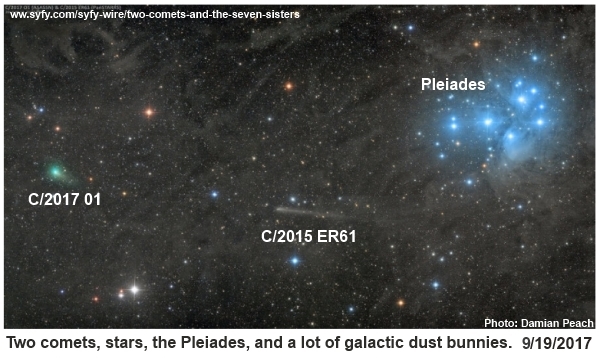
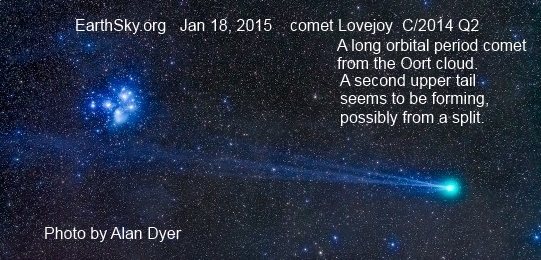
"Rabbi Moses Ben Nachman, ( Died 1270 AD) a Jew living in Spain, wrote of God taking two stars from Khima and throwing them at the earth in order to begin the great flood. (from "Comets in Ancient Cultures" By Noah Goldman U. Maryland, College Park Scholars) (Nachman probably quoting from Berakhot 59a of the Babylonian Talmud)
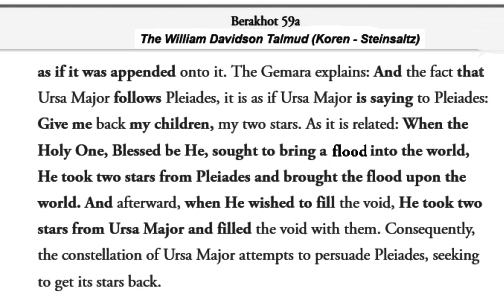
Why the added "as if" story? "Many different cultures have names for the Pleiades that often include the number seven, such as the 'Seven Sisters', 'Seven Maidens', or 'Seven Little Girls' . This might seem odd to modern observers, who can typically discern only six stars in the cluster."(space.com 10/08/19) "In Japan, the cluster is mentioned under the name Mutsuraboshi ("six stars") in the 8th-century Kojiki." (Wikipedia-Pleiades) The easily discernible number of stars has changed with time, apparently from 9 to 7 in ancient times, and from 7 to 6 more recently.
Amos_5:8 He who made the Pleiades and Orion, and turns deep darkness into the morning and darkens the day into night, who calls for the waters of the sea and pours them out on the surface of the earth, the LORD is his name; (ESV) H3598 kiymah BDB Def.: 1) Pleiades, a constellation of seven stars
Commentators John Gill and Albert Barnes agree that Amos 5:8 is concerning the time of the deluge !! Others do not !! "This can be no other than a memory of the flood ..." (Barnes) "as in the time of the universal deluge, to which some Jewish writers apply this ..." (Gill) (Possibly Gill is referring to the writers of the Talmud as he refers to the Talmud 340 times.)
Jamieson, Fausset, and Brown: "the seven stars — literally, the heap or cluster of seven larger stars and others smaller (Job_9:9; Job_38:31). The former whole passage seems to have been in Amos’ mind. He names the stars well known to shepherds (to which class Amos belonged), Orion as the precursor of the tempests which are here threatened, and the Pleiades as ushering in spring. ... calleth for the waters of the sea — both to send deluges in judgment, and the ordinary rain in mercy ... ."
Bible Knowledge Com.: "The rising of Pleiades before daybreak signaled the return of spring" ...
"When the ark came to rest...It was a new beginning; the world was clean and at rest."
Adam Clarke sees the description as that of rainfall per Job 36:27-28: "Calleth for the waters of the sea - Raising them up by evaporation, and collecting them into clouds. And poureth them out - to drop down in showers upon the face of the earth. The Lord has done this. Mathew Henry Agrees!
Amos does not plainly indicate any connection between the deluge and any number of stars in the Pleiades. He does include them within the same passages concerning the might of the Creator and His "pouring out" waters on the earth and as pointed out commentators Barnes and Gill believe this is referring to the deluge.
There can be doubt that the appearance of two stars/comets coming from the area of the Pleiades is a very realistic scenario! What was initially one comet can split and become 2 comets traveling together, like modern comet Biela (1825-1852). And each can become more fragmented like 57P/du Toit-Neujmin-Delporte (1994) and even further broken up when entering earth's atmosphere !! Comets can be 50% or greater water ice which can evaporate in the atmosphere and become rain. Most fragments, large ice chunks or dirt, reaching the surface would impact the seas, breaking them up, and a smaller number would impact land ! The effect on some areas of the earth would be catastrophic, but could be rather short-lived, the size of the comet being an important factor, and recovery to normal growing conditions needs to be within less than a year per Bible chronology as the occupants leave the ark to breed abundantly, be fruitful, and multiply on the land !

